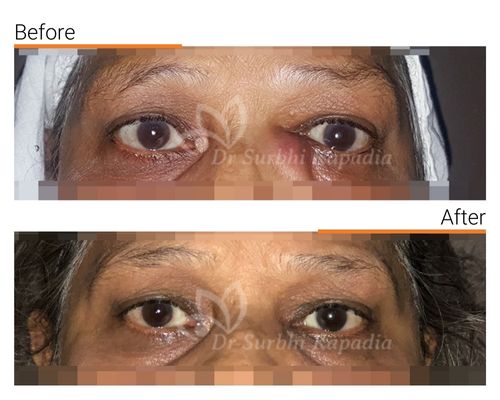Dacryocystitis

Dacryocystitis refers to the inflammation or infection of the lacrimal sac, the structure that houses our tears. This condition usually arises due to the obstruction or blockage of the nasolacrimal duct, which is responsible for draining our tears. Our eyes generate tears to keep them lubricated, which then gets drained via a tiny orifice known as punctum, situated in the inner corner of the eyelid. Following the canaliculus, a thin channel, the tears then flow into the lacrimal sac and eventually reach the nasolacrimal duct inside the nasal cavity.
Obstruction leading to dacryocystitis can occur anywhere along the tear-draining route. In newborns, it could be attributed to underdevelopment or blockage of the nasolacrimal duct. Whereas, in adults, inflammation, scarring, sinus or nasal cavity tumors, or infections can contribute to the obstruction. Interestingly, sometimes the nasolacrimal duct closes without any apparent reason – a situation termed as idiopathic.
Symptoms of dacryocystitis include an overflow of tears, commonly known as epiphora, or tears running down the cheek. Patients might also experience mucus discharge, crusting of the eyelids, and in severe cases, painful swelling and redness near the junction of the eyelid and the nose due to lacrimal sac infection. If left untreated, the infection might extend to the eyelids and even to the face.
Treatment for Dacryocystitis
Diagnostic Tests for Dacryocystitis
Syringing & Probing is a standard test for assessing excessive tearing. After applying local anesthesia, the tear drainage is dilated using a probe. A syringe attached to a cannula is then introduced into the tear duct, and the tear drainage system is flushed with a saline solution. Drainage ease and a salty taste in the mouth indicate normal functioning.
Therapeutic Interventions for Dacryocystitis in Vadodara
For minor obstructions, simple probing might be sufficient. However, in the case of acute dacryocystitis, topical and systemic antibiotics are required.
Dacryocystorhinostomy (DCR) is the most common surgical intervention for severe cases. During this procedure, a new passage is created for the tears to drain from the lacrimal sac into the nose, thereby circumventing the obstruction. An incision can be made either at the side of the nose (external DCR) or inside the nose (endoscopic DCR). Some patients might need temporary placement of a small silicon tube or stent to avoid early closure or scarring of the new tear drainage. The stent is typically removed after two to three months.
Potential Risks of Dacryocystitis Treatment
Though DCR is a straightforward procedure, it does carry certain risks, such as scarring at the incision site and the possibility of recurrence due to blockage of the newly formed drainage system.
Frequently Asked Questions About Dacryocystitis
After undergoing tear duct surgery, it is crucial to follow the post-operative care instructions provided by your ophthalmologist. This typically includes keeping the area clean, avoiding touching or rubbing your eyes, and promptly reporting any signs of infection or unusual discomfort to your doctor.
Post DCR surgery, it’s best to avoid activities that could potentially exert pressure on your nose and eyes. This includes forceful sneezing and nose blowing, especially during the first week after the procedure.
Typically, you are advised to wait for a week after DCR surgery before washing your face, to allow the surgical site to heal. However, in the case of endonasal DCR, you may be allowed to wash your face immediately. Always follow the specific instructions of your doctor.
After DCR surgery, you may experience mild discomfort and temporary swelling around the surgical area. These are normal post-operative symptoms and should subside as you recover. If carried out by an experienced professional, DCR surgery should not have any major adverse effects. Always consult with your doctor about what to expect in your specific case.
Dacryocystitis is caused by the blockage of the tear drainage system, particularly the nasolacrimal duct, leading to an accumulation of tears in the lacrimal sac which can result in infection or inflammation.
The most common cause of dacryocystitis in adults is idiopathic or unexplained closure of the nasolacrimal duct. In newborns, it can be due to the underdevelopment or blockage of the nasolacrimal duct.
The first line of treatment for dacryocystitis usually includes antibiotics, both topical and systemic, to manage the infection. In cases of chronic dacryocystitis or when there’s a persistent blockage, surgical intervention like Dacryocystorhinostomy (DCR) might be required.
Acute dacryocystitis typically progresses through three stages. The initial stage, or the pre-septic stage, is characterized by the blockage of the lacrimal sac, resulting in tear accumulation and swelling. This is followed by the acute stage, where infection sets in, leading to redness, pain, and potentially pus formation. If not treated, it can advance to the third stage or the abscess stage, where the infection can spread to surrounding tissues.
The diagnosis of dacryocystitis usually involves a clinical examination and a procedure called syringing and probing. During this test, the tear drainage system is flushed with a saline solution after dilation, and a note is made of easy drainage and a salty taste in the mouth.
Antibiotics can treat the infection associated with a blocked tear duct but won’t necessarily clear the blockage itself. If the tear duct blockage is due to swelling or inflammation, the antibiotics might indirectly help by reducing these symptoms. However, in case of physical obstruction, a surgical procedure might be required.
Dacryocystitis is commonly caused by Staphylococcus and Streptococcus species. However, a variety of other bacteria, including Haemophilus influenzae, Pseudomonas aeruginosa, and anaerobic bacteria, can also cause this condition.
Treatment of a swollen tear duct depends on the cause. If it’s due to an infection, antibiotics are usually the first line of treatment. For chronic issues or if the duct is blocked, a procedure like Dacryocystorhinostomy (DCR) may be necessary to create a new path for tear drainage.
General Oculoplasty
Ophthalmic Plastics
- Entropion / Ectropion
- Ptosis
- Thyroid Eye Disease
- Dacryocystitis
- Painful Blind Eye & Artificial Eye
- Stye (Chalazion)
Orbit and Ocular Oncology
Trauma
Aesthetic Oculoplasty
Non-surgical Cosmetic Procedures
Surgical Cosmetic Procedures


